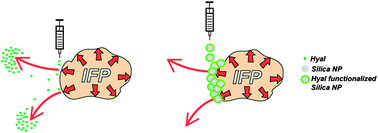Hyaluronan degrading silicananoparticles for skin cancer therapy†
Abstract
We report the first nanoformulation of Hyaluronidase (Hyal) and its enhanced

* Corresponding authors
a
Gerencia de Química, Comisión Nacional de Energía Atómica (CNEA), Av. Gral. Paz 1499, (B1650KNA) San Martín, Argentina
E-mail:
pscodeller@sanfordburnham.org
b Laboratorio de Aplicaciones Biológicas, Departamento de Micro y Nanotecnología, Comisión Nacional de Energía Atómica (CNEA), Av. Gral. Paz 1499, (B1650KNA) San Martín, Argentina
We report the first nanoformulation of Hyaluronidase (Hyal) and its enhanced

 Please wait while we load your content...
Something went wrong. Try again?
Please wait while we load your content...
Something went wrong. Try again?
P. Scodeller, P. N. Catalano, N. Salguero, H. Duran, A. Wolosiuk and G. J. A. A. Soler-Illia, Nanoscale, 2013, 5, 9690 DOI: 10.1039/C3NR02787B
To request permission to reproduce material from this article, please go to the Copyright Clearance Center request page.
If you are an author contributing to an RSC publication, you do not need to request permission provided correct acknowledgement is given.
If you are the author of this article, you do not need to request permission to reproduce figures and diagrams provided correct acknowledgement is given. If you want to reproduce the whole article in a third-party publication (excluding your thesis/dissertation for which permission is not required) please go to the Copyright Clearance Center request page.
Read more about how to correctly acknowledge RSC content.
 Fetching data from CrossRef.
Fetching data from CrossRef.
This may take some time to load.
Loading related content
